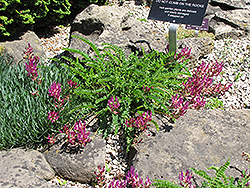It's all about ...
plants

Monpellier Milk Vetch
Astragalus monspessulanus
Plant Height: 8 inches
Flower Height: 14 inches
Spread: 24 inches
Sunlight:
![]()
Hardiness Zone: 6b
Description:
A selection that will add incredible interest to the rock garden; lovely lavender blooms emerge in late spring over the unusual stems that are studded with tiny oval leaves arranged uniformly; prefers well drained and mostly sunny areas, can spread
Ornamental Features
Monpellier Milk Vetch is covered in stunning clusters of pink pea-like flowers with lavender overtones and creamy white eyes at the ends of the stems in late spring. Its tiny oval pinnately compound leaves emerge light green in spring, turning green in colour throughout the season.
Landscape Attributes
Monpellier Milk Vetch is an herbaceous perennial with a ground-hugging habit of growth. It brings an extremely fine and delicate texture to the garden composition and should be used to full effect.
This is a relatively low maintenance plant, and is best cleaned up in early spring before it resumes active growth for the season. It is a good choice for attracting bees and butterflies to your yard. Gardeners should be aware of the following characteristic(s) that may warrant special consideration;
- Spreading
Monpellier Milk Vetch is recommended for the following landscape applications;
- Rock/Alpine Gardens
- General Garden Use
- Naturalizing And Woodland Gardens
Planting & Growing
Monpellier Milk Vetch will grow to be about 8 inches tall at maturity extending to 14 inches tall with the flowers, with a spread of 24 inches. Its foliage tends to remain low and dense right to the ground. It grows at a medium rate, and under ideal conditions can be expected to live for approximately 15 years. As an herbaceous perennial, this plant will usually die back to the crown each winter, and will regrow from the base each spring. Be careful not to disturb the crown in late winter when it may not be readily seen!
This plant should only be grown in full sunlight. It prefers dry to average moisture levels with very well-drained soil, and will often die in standing water. It is considered to be drought-tolerant, and thus makes an ideal choice for a low-water garden or xeriscape application. It is not particular as to soil pH, but grows best in poor soils. It is somewhat tolerant of urban pollution. This species is not originally from North America. It can be propagated by division.
This plant is not reliably hardy in our region, and certain restrictions may apply; contact the store for more information.

